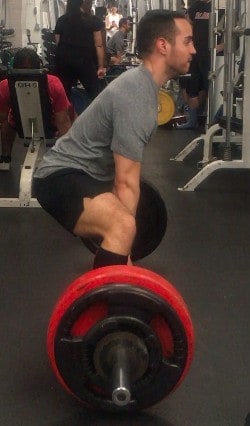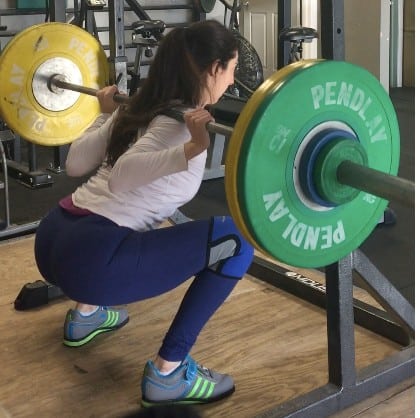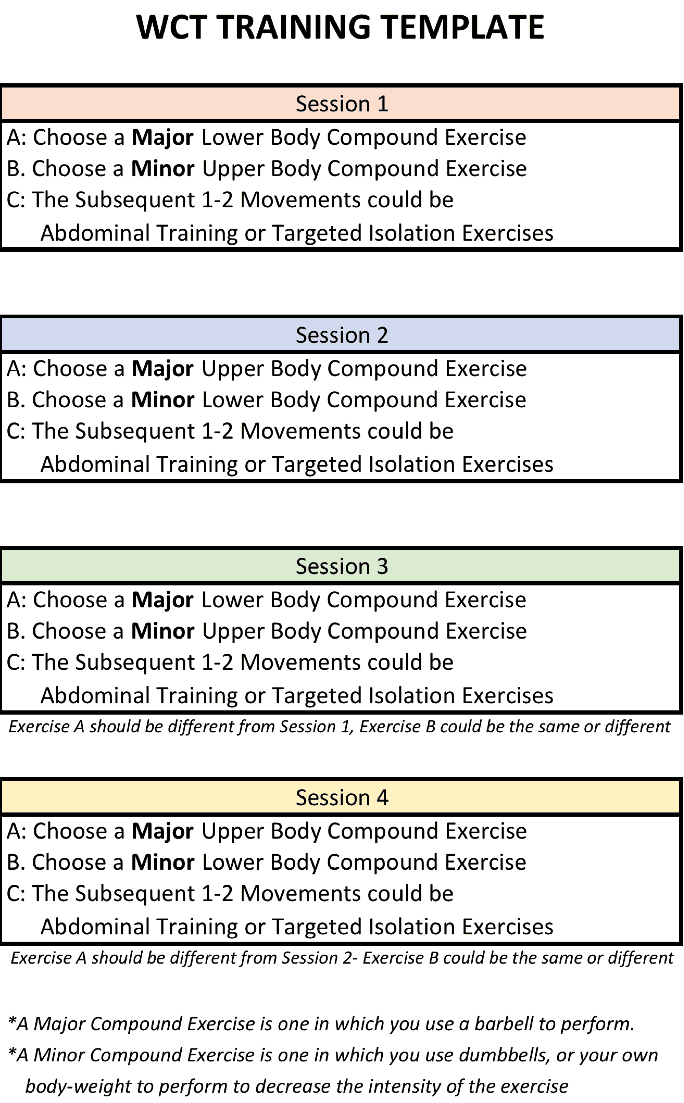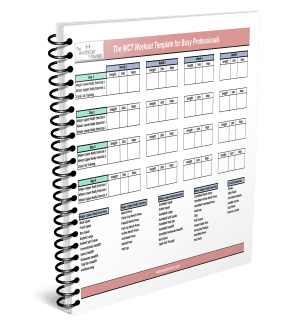If you’re looking for the an efficient full-body workout split, you’re in the right place.
After reading this post, you’ll learn how to create a comprehensive workout to target every single muscle group in your body.
You’ll also get a free PDF workout template to get started.
The best part?
You can do it in just 30 minutes a day.
Let’s get started.

This is the third installment of the WCT Workout series: You can find part 1 and 2 here
- Part 1: 3 Essential Principles of Exercise You Must Understand Before Working Out
- Part 2: How To Design Effective Workout Routines in 3 Simple Steps
What Is A Full Body Split?
A full body split (or total body training) is where you train muscle groups from both your upper body and lower body on the same day.
For example, if you perform the bench press, the squat, and core work on the same day – that would be considered a full-body split.
It DOES NOT mean that you train every single muscle group (or your entire body) in one workout.
What Is The Benefit Of A Full Body Workout?
The major benefit of full body training is that it allows you to increase your training frequency.
In other words, you get to practice the major compound lifts more frequently, increasing your total training volume.
This is in contrast to training each muscle group once per week.
Research demonstrates that training each major muscle group twice per week is superior to once per week in terms of muscle hypertrophy and strength gain.
3 times per week may be better, but 2 is easier to do.
Who Should Do This Split Routine?
This split is perfect for beginners and early intermediates.
It’s simple, concise, and it’s proven to get results.
Lastly, you don’t need to train more than 3-4 days a week using this training, which is ideal for busy students and professionals.
How Many Times A Week Should You Do a Full Body Workout?
In general, I recommend that you work out 4 days a week.
But keep in mind, 4 days a week is simply a guideline.
If you don’t have a stable or predictable schedule, it is acceptable to have a range of training frequencies.

You can train anywhere from 2-5 days a week and still get great results. Aim for fewer training sessions on busier weeks, and more training sessions on lighter weeks.
The Optimal Set Up is
- Two consecutive training days,
- One day off,
- Two consecutive training days,
- Two days off
For example, this is what your training would look like
| Monday | Workout #1 |
| Tuesday | Workout #2 |
| Wednesday | Off |
| Thursday | Workout #3 |
| Friday | Workout #4 |
| Saturday & Sunday | Off |
Mon, Tue, Thur, and Fri serving as training days, with Wed, Sat, and Sun serving as a rest day.
If your schedule forces you to make a gym schedule in any other pattern from this, that is okay. Just pick up where you left off and keep going.
How Often Should You Workout Each Muscle Group?
For every major muscle group, the ideal number of times to train them is twice a week.
This is also in line with the CDC recommendations for muscle strengthening for adults.
What are the major muscle groups?
You can train all of these two times per week as they only need 2 days to recover.
I know what you’re thinking.
If you only train 30 minutes a day, 3-4x a week, how can you possibly hit each muscle group twice in a week?
The answer is simple: compound exercises.
What Exercises Should You Include In Your Full Body Workout Split?

In order to benefit the most from a total body workout, it is important to fill your workout routine with compound exercises.
Especially the 6 movement patterns that were discussed in Part 2 of this series.
These include:
- A Squat variation (eg Front Squat)
- A Deadlift variation (eg Sumo Deadlift)
- A Horizontal Press variation (eg Bench Press)
- An Overhead Press variation (eg Dumbbell Shoulder Press)
- A Row variation (eg Barbell Row)
- A Single Leg movement pattern (eg Lunges)
Compound exercises are an easy way to train 2-3 muscle groups simultaneously, helping you save the little precious time you have.
With that said, it is OKAY to train them once a week if you simply cannot train each muscle group two times in that time period.
Do not forget, something is ALWAYS better than nothing when it comes to exercise.
There are very few things in life you could say that about.
How Long Should The Workout Be?
You do not need to spend 60 minutes in the gym to achieve results.
Unless you are lifting really heavy weights, or training for some sort of competition there is no reason to spend countless hours per week at the gym.
Believe it or not, 30 minutes is enough time to get a lot of work done.
I know that you don’t have much time to waste, therefore, your workout sessions need to be compact!
If you design your workout program correctly, you can accomplish a lot of work in a short amount of time.
It is all about training smart, and training efficiently.
So without further ado, here is the full-body workout routine.
The Best Full-Body Workout Routine For Beginners
Here is the White Coat Trainer 4 day split for busy people.

Click Here To Download Your Free Full Body Workout Plan PDF!
The PDF above will teach you which exercises are
- Major Upper Body Exercises
- Major Lower Body Exercises
- Minor Upper Body Exercises
- Minor Lower Body Exercises
And you can find video descriptions of all of them in The Complete List of Compound Exercises [46 Variations].
The Most Important Components of this Template
This workout plan should ALWAYS be preceded by a warm-up routine. Warmups serve to prepare your body for physical activity, and as such, will decrease any risk of injury.
I warm up in 5 minutes. How? I wrote about it at The Most Efficient Warm Up Routine for Busy Individuals.
This template was designed with two major principles in mind:
1) Efficiency: It focuses on compound exercises for the majority of the workout so that you can spend less time in the gym while maximizing your progress.
2) Balance: It balances the amount of work you perform on your upper body and lower body, as well as the amount of work you perform on your anterior muscles (chest, quads etc) and posterior muscles (back, glutes etc).
How to Progress through the Exercise Template
Once you have finished Session 4, go back to Session 1 and make a small modification to the Major Compound Exercise.
Then you will do the same with Session 2- making a small modification to the Major Compound Exercise, and so on.
How do you make a small modification?
The first principle of exercise states that training stimuli must change over time. Every time you repeat a session, there must be something different about it.
Simple training modifications include:
- The number of reps performed,
- The number of sets performed
- The amount of weight lifted
Refer to How Many Sets And Reps Should You Do to identify which rep ranges and sets are ideal for your goals.
If you are a busy student/professional, I recommend that you stick with 3 sets of 7-12 repetitions for the majority of your training.
By implementing this strategy, you are constantly introducing a new progressive stimulus to your body to drive stronger adaptations over long periods of time.
You can also change the stimulus by using a different variation of the compound exercises every 4-8 weeks.
I go over 10 different ways to make progress in my article on Progressive Overload.
Here are other strategies to live by…

START LIGHT
When performing your workout routine, always start small. Begin with very light weights that you can perform easily.
Allow your body to slowly accustom itself to the exercises. Learn the proper technique in a safe manner to maximize the benefits of the compound exercises.
Don’t forget, we are in it for the long haul!
There is no reason to go all out on day 1 or even day 40. Let your body grow stronger over long periods of time.
SET SMALL GOALS
Modify each workout gradually. Don’t lift 185 lbs today and then 205 lbs the next session.
This is a recipe for failure.
Only increase the weight by a very small margin (2.5 – 5 lbs max), or increase the number of repetitions performed by only 1 rep per session (In order to do this, you will need fractional plates).
It’s not much, I know.
But trust me, you want this process to be slow, controlled, and easily adaptable. By taking your time, you ensure that you can continue to make progress from session to session.
KEEP A RECORD
There is nothing more satisfying than seeing the progress you have made in your life. Think back to anything in your life, and see how far you have come.
Feels good, doesn’t it?
I can tell you with complete certainty- the feeling of accomplishment that you get from exercise and fitness is unparalleled.
Keeping a training log of your progress will allow you to do several things:
- See your progress over the years
- Evaluate your training to see where you can make improvements
- Review things that have and have not worked for you in the past so that you can continue to plan accordingly
Oh, and by the way, progress photos are worth a million words.
CREATE THE HABIT TO ESTABLISH A ROUTINE
If you are going to take anything away from this post it is this:
Any routine is better than no routine.
Hold yourself accountable. Make it to your workout sessions, in whatever manner you need to.
Make your health a priority, just like you did with your career.
Fitness and construction are very similar.
Every building is constructed by laying down one brick at a time. Keep laying your bricks and you will build something anyone would be proud of.
Now let’s wrap up with some FAQ’s.
Frequently Asked Questions

Is full body better than split training?
Full body training isn’t necessarily the best training split. If you are a beginner and don’t have a lot of time to work out, full body is the way to go.
But it’s not the only choice. To learn about two other ways to split up your training, check out the 3 Best Split Workouts of all time.
You can’t go wrong with any of those choices.
With that said, don’t waste your time with bro splits.
Bro splits dedicate an entire session to just one muscle group per day.
For example:
- they train arms on Monday,
- chest on Tuesday,
- legs on Wednesday etc.
Are bro splits bad? Not necessarily. But they aren’t efficient for building muscle.
But if you are a busy beginner, I recommend the Full Body Split for one major reason.
The Full Body split ensures that you train your upper and lower body evenly, especially if your schedule is unpredictable.
Can you build muscle with a full body workout?
Full-body workouts are one of the best ways to build muscle mass. But in order to do so, you must:
- Focus on large compound exercises more so than isolation exercises
- Progressively overload your workouts (making small simple training modifications) over time.
- Recover appropriately between workouts
- Consume enough protein and carbohydrates
I cover this in more detail in How To Maximize Workout Recovery.
Are full-body workouts good for beginners?
Full-body workouts are great for beginners for three reasons:
- The workouts are simple
- You focus on only a handful of exercises
- You get to practice the major compound exercises frequently
- You only need to workout 3-4x a week.
Just make sure to learn how to perform these exercises properly. Have someone assess your form when starting out.
How many exercises should I do per workout?
That’s the beauty of full-body training. You only need a handful of exercises per workout.
I recommend 4 exercises per workout, as the template above shows.
I almost always stick to this guideline and have seen amazing results.
I go into more detail in How Many Exercises Per Workout Should You Do?
Is It OK To Do A Full Body Workout Everyday?
Unless you are training for a competition, or you get paid to workout, you should NOT do a full-body workout every day.
3-4 day a week is more than enough.
Can I Do A 3 Day Workout Split Using This Split?
There are two ways to do 3 day full body splits. The first option looks like this:
- Workout #1 on Monday
- Workout #2 on Wednesday
- Workout #3 on Friday
- Workout #4 on Monday of Week 2
- Workout #1 on Wednesday of Week 2 and so on.
The other option is to just use three unique workouts which you do once per week. I give you an example in our article on workout splits.
How Long Should A Beginner Do Full-Body Workouts?
Beginners should stick to full-body training for at least 3-4 months.
In fact, I have done all the work for you.
Why take 3-4 hours to piece together all of this information into a cohesive plan?
This is why I created the WCT Strength Program.
We take all of the principles in this article (and more) to create a 15 week exercise program for you that you can do in just 35 minutes a day.

Can I Do A Full Body Workout At Home?
It is possible to do a complete bodyweight version of this workout at home with minimal equipment.
Check out my Calisthenics At Home Workout post to learn more.
Final Words On The Full-Body Workout Split
Workout routines don’t have to be complicated.
They don’t have to be long.
It doesn’t have to be difficult.
It only requires you to make a decision.
If your goal is muscle gain and fat loss – full body strength training can help you get there!
In a nutshell,
- It’s best to train 3-4x a week on average, but deviations from this are okay
- Train each major muscle groups 1-2 times a week for the best results
- Use full body splits and spend the majority of your time using compound exercises for maximum efficiency
- Start light, progress slowly, and make small, realistic goals
- Something is always better than nothing in the fitness realm
Related Posts On Split Training:
- A Complete List Of The Best Compound Exercises
- The Upper/Lower Split – How To Do It Effectively
- The 3 Best Workout Splits of All Time
Now we turn it over to you.
What workout templates have you used before?
How long do your workouts take?
Leave a comment below and let us know!
P.S Share this workout template if you found it useful.
And don’t forget to download a copy of this workout template to get your training started!

Alex Robles, MD, CPT / Brittany Robles, MD, MPH, CPT
Alex & Brittany Robles are physicians, NASM CPTs, health & fitness experts, and founders of The White Coat Trainer: a site dedicated to improving the health and fitness of busy professionals. Their advice has been featured on KevinMD, The Doctor Weighs In, My Fitness Pal, Reader’s Digest, Livestrong, and The Active Times. Learn more about them here.


I have to tell you all, I have read all your posts up to this point and your insight is incredibly helpful. This training template is golden! It all makes so much sense when I read the rationale; it would have taken me forever to figure out on my own, though. (…and wasting time is not something I have time for!) Thank you for such clear and concise direction!
Thank you very much for the kind words. I am very grateful that you found it helpful. Let us know if there is anything else in particular you would like us to write about.
Thank you for providing these templates.Each session has only 3 exercises….is that enough or I can add other exercises?Also I like to do cardio 3 times a week. What would be the best way to combine cardio with weights?
You’re welcome. You can certainly add other exercises to the template. The reason why there are three exercises per day is because this template was designed to be done in 35 minutes per day. If time constraints aren’t a big deal for you, you can add more exercises. You can combine cardio with weights in many different ways, with the most common method being on your off days. You don’t want to do anything excessively strenuous or it may take away from the recovery of the weights. Other people also include a short cardio workout after their lifting. Either approach is fine. I speak more about this in the post titled A Proven Cardio Workout to Lose Weight Despite Your Busy Schedule. Hope this helps.
Great Thank You i know laying a good foundation is very important and using compound exercises right now I need to strengthen my trunk and core i know this will help my whole body. Thank You
You’re welcome Stephen!